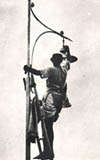Brihanmumbai Electric Supply and Transport
In 1947, the company became an undertaking of the municipal corporation and rebranded itself to Bombay Electric Supply & Transport.
Although a licence was granted, the project was never realized due to the prevailing economic depression in the city brought on by the end of the American Civil War, during which Bombay had made vast strides in its economy by supplying cotton and textiles to the world market.
[1] On 9 May 1874, the first horse-drawn tram made its debut, plying the Colaba–Pydhone route via Crawford Market, and Bori Bunder to Pydhonie via Kalbadevi.
Later that year, a 4,300 kilowatts (5,800 hp) steam power generator was commissioned at Wari Bunder.
[4] The passing years aggravated the problem of rush-hour traffic, and to ease the situation, double-decker trams were introduced in September 1920.
Despite stiff opposition and protests by taxi drivers, the service ran without a hitch, transporting 600,000 passengers by the end of that year.
In response to pleas by the government and the Bombay Municipal Corporation, the company extended its services to the northern part of the city in 1934.
The Indian independence movement's call for mass nonviolent strikes and general civil disobedience led to regular service disruptions, causing the company to incur huge losses in 1929.
To remain solvent, it decided to introduce discounted fares for short routes and increase its coverage to the northern portions of the city.
Pursuant to the option given to it under the deed of concession granted to the Bombay Electric Supply and Tramways Co. Ltd, the BMC acquired the assets of the combined undertaking, namely the operation of tramways and distribution of electricity in the city of Bombay as a going concern on 7 August 1947.
By mutual agreement, the corporation also took over the operation of bus services, which were run by the Bombay Electric Supply & Transport Company.
The case dragged on for four years before the Supreme Court of India granted the organisation a complete monopoly over bus services in the Greater Bombay area.
In 1964, due to high operational costs and poor public support, its long-running tram services were terminated.
[9] With the renaming of the city from Bombay to Mumbai in 1995, the organization was rebranded as Brihanmumbai Electric Supply & Transport (BEST).
Following a Supreme Court directive, the company gradually phased out old buses and introduced new ones that complied with Euro III pollution control standards.
[10] On 19 November 2004, route SPL-8, travelling from Churchgate to the World Trade Centre, began accepting cashless smart cards for automatic fare collection on BEST buses.
[13][14] The company placed a ₹36,750,000,000 (US$Formatting error: invalid input when rounding) order with Olectra Greentech to supply and maintain 2,100 battery electric single-decker buses for a 12-year period in May 2022.
Inside the buses, there are LED indicators displaying route and destination as well as upcoming stop names.
As of 2021, the BEST runs approximately 3,800 buses,[22][23] ferrying 5 million passengers[24] over 443 routes, and has a workforce strength of 38,000, which includes 22,000 bus drivers and conductors.
[27] On 9 September 2022, BEST announced an advance ticket reservation system for its airport bus service through the Chalo App [28]
The museum was founded by P D Paranjape, the BEST officer who religiously collected bus tickets, engines, ticket-issuing machines from depots across the city.
The power cables are laid underground, which reduces pilferage and other losses that plague most other parts of India.
Unlike the transport company, the electricity department services only the Mumbai City area, and not the suburbs.
It provides power to 5 million residential and commercial establishments[32] and over 33,000 street lights within the city limits.
[37][38] Newer management techniques, such as retrenching of excess staff (494 till date),[39] and the closure of less patronised routes, have reduced the losses in recent years, from a high of ₹ 1.75 billion ($40.1m) in 2001.
In July 2005, the company floated tender inquiries to 54 banks to exchange the loose change, which totalled ₹ 46.7 million ($1.07m).
However, none of the banks sent in a single bid, some citing that their vaults are full, and others saying it would be unprofitable for low denominations, given security considerations.
The BEST, being a public utility company, cannot increase electricity and bus fares to maximise its profits.
When BEST decided to do away with the double-deckers for operational reasons recently, public protests and sentiment forced it to continue with the service.
Bus drivers and conductors have come in for praise in the media for their service during the 2005 Mumbai floods, when they ensured that all the stranded passengers were dropped safely to their respective destinations.











